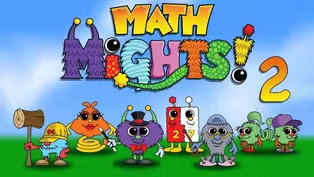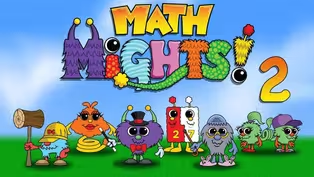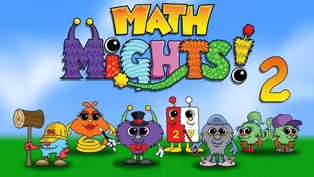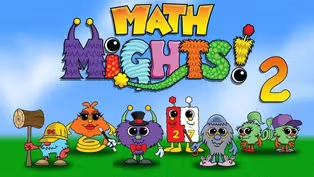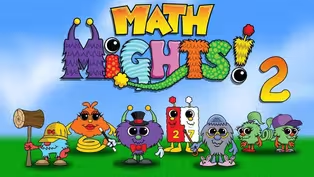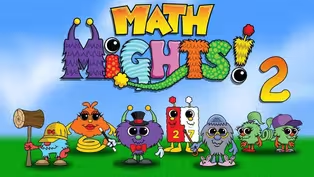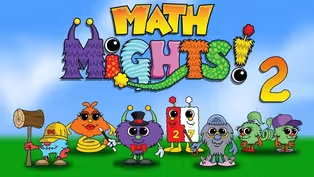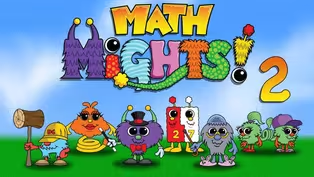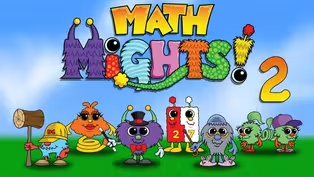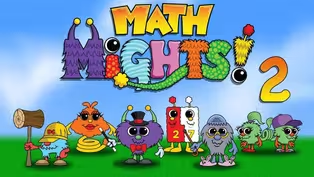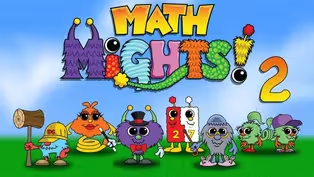Math Mights
Represent 100s Different Ways
Season 2 Episode 217 | 15m 59sVideo has Closed Captions
Join Mrs, McCartney for a Number Talk with her friend Springling!
Join Mrs, McCartney for a Number Talk with her friend Springling! Next get ready to have some fun with base ten blocks and place value discs to represent 100s different ways.
Problems playing video? | Closed Captioning Feedback
Problems playing video? | Closed Captioning Feedback
Math Mights is a local public television program presented by Detroit PBS
Math Mights
Represent 100s Different Ways
Season 2 Episode 217 | 15m 59sVideo has Closed Captions
Join Mrs, McCartney for a Number Talk with her friend Springling! Next get ready to have some fun with base ten blocks and place value discs to represent 100s different ways.
Problems playing video? | Closed Captioning Feedback
How to Watch Math Mights
Math Mights is available to stream on pbs.org and the free PBS App, available on iPhone, Apple TV, Android TV, Android smartphones, Amazon Fire TV, Amazon Fire Tablet, Roku, Samsung Smart TV, and Vizio.
Providing Support for PBS.org
Learn Moreabout PBS online sponsorshipMore from This Collection
"Math Mights" lessons for 2nd Grade students.
Video has Closed Captions
Join Mrs. McCartney for some fun with Professor Barble. (15m 59s)
Video has Closed Captions
Join Mrs. McCartney for some fun with Professor Barble. (15m 59s)
Video has Closed Captions
Join Mrs. McCartney for some fun with Professor Barble doing a tricky comparison. (15m 59s)
Video has Closed Captions
Join Mrs. McCartney for a word problem with Professor Barble that will make more sense. (15m 58s)
Video has Closed Captions
Join Mrs. McCartney for a comparison word problem with her friend Professor Barble. (15m 59s)
Compare 3-Digit Numbers Part 2
Video has Closed Captions
Join Mrs. McCartney to learn how to do a comparison word problem with Professor Barble! (15m 59s)
Comparing Numbers on a Number line
Video has Closed Captions
Join Mrs McCartney for a word problem with Professor Barble using Visula Models! (15m 59s)
Compare 3-Digit Numbers Part 1
Video has Closed Captions
Join Mrs. McCartney to see if we can figure out Professor Barble's comparison. (15m 59s)
Numbers represented in different ways
Video has Closed Captions
Representing numbers in different ways to show off your learning with place value. (15m 59s)
Video has Closed Captions
Put numbers together and taking them apart with expanded form. (15m 59s)
Video has Closed Captions
Join Mrs, McCartney for a Number Talk with her friend Springling! (16m)
Subtraction with 2-Digit Numbers Part 2
Video has Closed Captions
Join Mrs. McCartney for an addition number talk with D.C.! (16m)
Providing Support for PBS.org
Learn Moreabout PBS online sponsorship(light music) (whooshing) - [Kids] Math Mights.
- Welcome second grade Math Mights, My name is Mrs. McCartney.
I'm so excited that you have joined us today to learn about math.
Let's check out what we have in store for today.
Today, we're gonna start off with a number talk with my friend Springling from the Math Mights, and then we're going to be talking a lot about place value looking at representing 100s different ways.
Let's start off first with our number talk.
First in step one, I'm gonna pose a problem with an operation that you already are familiar with.
The next step is going to be to try to solve the problem mentally without pencil and paper.
So you're gonna think through how you might solve it.
Step three is you're gonna share out how you solved it or how you went about solving it, and explain your strategy.
Let's check out to see who's gonna help us with our number talk today.
It's my friend's Springling.
Springling was born in Math Ville in the subtraction world with a coily tail, fancy eyelashes, and fluffy fur.
She loves to hop on the open number line when she's doing subtraction.
So when we're doing our number talk today, I want you to think of Springling and everything that you've learned about Springling to help you hop on friendly numbers, like decade numbers, like 10, 20, 30.
That's gonna help you during this number talk to think about the strategy mentally.
Let's see what our problem is that Springling has for us today.
Springling wants us to solve the problem 42 minus 29.
Think about that just for a second, are you seeing some friendly decade numbers that are near that?
Let's talk to my friend Fatima and find out how she solved this problem using Springling.
It looks like she started off with the number 29 and then hopped to 30, that's a friendly decade number.
Let's check out a little bit slower to see how Fatima did it so that you have an idea of how you can use this strategy.
So let's go ahead and make our number line.
I'm gonna start it at 29 because I would start at 29 if I was counting and I'm gonna end my number line at 42.
Remember we talked about in subtraction, it's the distance between two numbers that we're looking for.
And so when we looked at Fatima's strategy, she went from 29, and then she stopped at a friendly number 30.
That's really close to 29 and it's very easy to figure out the distance.
So we're gonna tell Springling to hop, Springling hop.
The distance between 29 and 30 is one.
Now we're gonna look at what the next decade number is.
If I was counting by 10s, I know that I'm gonna hit 40.
So hop, Springling hop, that's easy to put that 10 in there.
Hopping from 40 to 42 is a cinch, we're gonna hop that last part of it and know that we only went two.
Remember, Springling loves to keep track of how far she's hopped.
So let's see if she did 10 plus her two plus her one, we know that is the total hops was 13 which means that was the distance.
So 42 minus 29 is 13.
Let's check out to see how my friend Kysa thought about Fatima's was way.
She has a thought.
"I agree with the way Fatima solved the problem, and I used the same strategy" but she used it in a different way.
I see that she did use the open number line just like Fatima did, but it looks like she counted a little bit differently.
She thought of it from hopping from 29, all the way to 39.
I wonder why she did that.
I think that she was thinking that hopping by 10s is easy, you can skip count by 10s with any number.
So let's start off hopping from that 29 to 39, have a hop Springling hop, I know that that is 10.
Now she's looking at the distance between 39 and 42.
That's pretty easy to figure out, we know that is three.
So as Springling hops, we're gonna add those together and she ended up getting 13 which is the same answer that Fatima did.
I know that Springling would be so proud of how we did with our number talk today because we solved with Springling but we solved two different ways.
Did you solve it one of those ways?
Or perhaps you had a different strategy that you used for our number talk.
Let's check out our I can statement for today.
Today it says I can represent 100 in different ways.
We're gonna have a great time today using different manipulatives that are going to be able to be able to represent 100.
Let's check out to see what we want you to look at first.
Andre used base-10 blocks to represent a number.
He built this on his place value mat.
How many do you see, and how do you see them?
I see them arranged in different ways, and there's probably a different ways that you could go about counting it.
Let's talk to Fatima and Kysa to see how they solved it.
Fatima said, "I see 96 because there's nine 10s and six ones."
Let's take a look to see a little bit closer because when I first looked here, I see eight 10s.
Let's see how she's going about counting this, 10, 20, 30, 40, 50, 60, 70, 80, which is equal to eight 10s, and then it looks like she looked at these ones here as one whole group of 10, which is really great on her part.
So she sees here nine 10s, and then she sees the six ones to total 96.
Let's see how Kysa is thinking of it.
Kysa thinks of it a little bit differently.
She sees eight 10s and 16 ones.
If we go back here, I see exactly what Kysa is talking about because we have our eight 10s.
Then if we look at all the groupings of one over here, we can see that there's 16, which makes eight 10s and 16 ones.
Excellent thinking.
Let's see what Andre is going to do to the place value blocks next.
Andre decides to add more blocks.
What do you think he discovered?
What do you think the value is now?
He added more blocks to what he has.
I'm gonna go ahead and add the blocks that Andre did so we can see what that total looks like.
This now shows how many Andre put on.
Let's see what Fatima says.
She says that she counted by 10s and can see that there's 100.
Do you see how to count by 10s with this picture we're looking at?
Let's take a look down here.
10, 20, 30, 40, 50, 60, 70, 80, this group of 10 is another set of 10, which makes this 90 and then 100, that's one way that we could look at it.
Let's see now how Kysa thinks of it.
She said that she just counted on from 96 to 100.
We originally had 96 and then Andre added on some more.
So let's take a look to see what that looks like.
We see the 96, 97, 98, 99, 100.
Those are both really great ways to be able to use the base 10 blocks to help us see the total of 100.
Let's think about another scenario with this.
Andre wants to make this same number with the fewest possible blocks.
What would that look like?
I want you to think about that a little bit and what you know about base 10 blocks.
There might be multiple ways that we could think of that.
Let's take a look here to see what is it that we could exchange these for.
We know that these here are each equal to 10.
So could we take these two and exchange them for two of our 10s?
I think we could.
So let's go ahead and clear these away, and then I'm going to add two more 10s.
That is definitely using less blocks than we were using last time.
One, two, three, four, five, six, seven, eight, nine, 10, 10 10s equals 100.
That was a great way to be able to think of 100 more than one way.
Do you think that we could use even the less blocks than we did just that last time, let's take a look.
If I know that this is 10 10s, and 10 10s equals 100, we can put it this down, which is this exactly matches up the same as our 10 10s here.
So this is our 100 block that would be way less blocks to be able to use if we want it to show the number 100.
So if we know that the grid shows there that it's a 100 we also know that 10 10s is the same as 100.
What if I told you, you could use as many blocks as you wanted to, to show 100.
We know that that would equal 100 ones would be the same as 100.
Do you think there's more than one way to be able to make 100 like we did before?
I know we saw it with ones, and we saw with 10s, but I bet there's other ways that we could think of to how to make 100.
Let's check this out on one of my favorite math manipulatives, the Abacus.
Here's our Abacus here.
As you can see, there is red and white.
There's lots of characteristics about the Abacus that will help you to understand it.
There's five red and five white, which tells that that is equal to one 10, just like our base 10 blocks.
There's always a switching in the colors in most of the Abacus to indicate that the top is 50 and the bottom is 50.
This equals 100, 10, 20, 30, 40, 50, 60, 70, 80, 90, 100.
So either 100 ones, like we said equals 100, or we have those 10 groups of 10 that equal 100.
Let's see if we can come up with two other ways that we could name 100.
If I were to over 10, 20, 30 ones how many 10s would there be?
One, two, three, four, five, six, seven 10s.
So here we see seven 10s and then we see 30 ones.
That's another way that we can make 100.
Let's try one more.
I wanna be able to show 100 with two parts, so I'm gonna go ahead and push over 10, 20, 30, 40, 50, 60 ones, so I counted these individually.
So 60 ones plus one, two, three, four 10s.
Four 10s plus six 60 ones also equals 100.
We could make 100 in many different ways as we decompose or break apart that number.
As long as you're familiar with 10s and ones.
You did a great job using our Abacus today.
There's another type of manipulative that I love using with place value, and as a second grader, I want you to know the names for those.
So we have proportional versus non-proportional.
What are proportional manipulatives that you might see inside of a classroom?
Some of those things you might be familiar with like base 10 blocks, or even unifix cubes or snap cubes that equal one, if you put 10 together, it's 10, if you put 100 together, it's 100.
So it's known as proportional.
What are manipulatives that would be non-proportional?
These would not equal the same size or the same value depending on how we look at it.
One of the things that I can think of is a nickel versus a dime.
This is definitely non-proportional.
A nickel is really large so you would think that it actually would be worth more, where a dime is quite small, but it has a higher value.
So a nickel and a dime are an example of a non-proportional manipulative because the size doesn't equal their value, they're non-proportional.
Another fun manipulative that I love to use is place value discs.
These place value discs, they are all the same size, right?
But they are not the same value.
This is valued at 1,000, 100, 10, and one all the same size different values.
When we look over here at the proportional manipulative one is one, and if I keep that same one going it says equal to one 10.
Proportional versus non-proportional.
And second grade is a great time for your brain to start to learn the differences between these two.
You don't have to always use base 10 blocks, you don't have to always use place value discs, but we can do activities with both of these.
So let's check out to see how we're gonna do an activity using a different manipulative.
Let's see if we can build a number using our place value discs.
We wanna be able to build with place value discs 90.
Let's take a look to see how we build that with 10s.
So if I started counting and I wanted to see how many 10s it is, I could count like this, 10, 20, 30, 40, 50, 60, 70, 80, 90, the total equals 90 and we know that equals nine 10s.
Let's say we wanted to see if we could build 110.
I know that this is 90, so if I kept counting 10, 20, 30, 40, 50, 60, 70, 80, 90, 100, 110.
So the total of this equals 110 and we know that we have 11 10s that would equal 110.
Let's say, now we wanted to go ahead and build 150.
How many 10s would that be?
I know here I have 110, so if I continued 120, 130, 140, 150, all of this equals 150, and we know that we have a total of 15 10s.
Using place value discs is so much fun.
We did a great job being able to go all the way up to 150.
Now it's your turn to play a game called base 10 compare.
You're gonna be able to use everything that you learned in our session today, to be able to battle against someone else to see who has more base 10 blocks.
Math Mights I have had so much fun hanging out with you today.
I sure hope that you'll join us next time.
Thanks so much for joining us.
(light music) (gentle music) - [Announcer] sis4teachers.org.
(words whooshing) Changing the way you think about math.
(playful music) - [Announcer] This program is made possible with funding from the Michigan Department of Education, Governor's Education Emergency Funds, the State of Michigan, and by viewers like you.
(bright music)


- Home and How To

Hit the road in a classic car for a tour through Great Britain with two antiques experts.












Support for PBS provided by:
Math Mights is a local public television program presented by Detroit PBS
